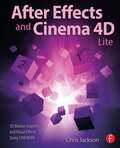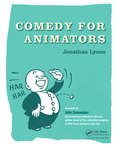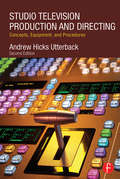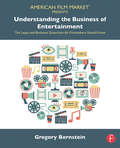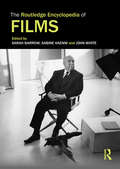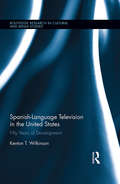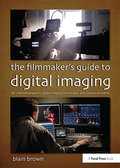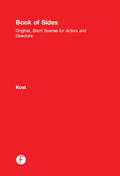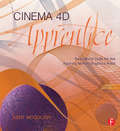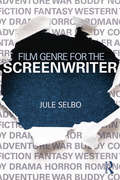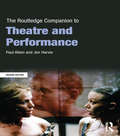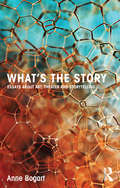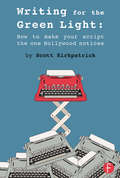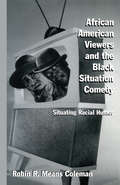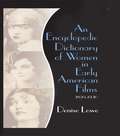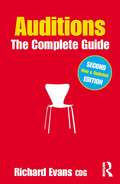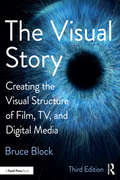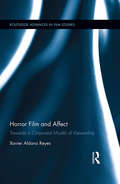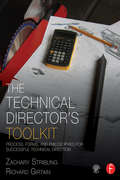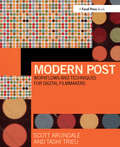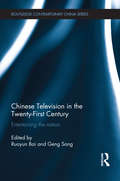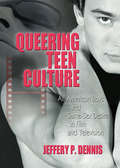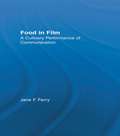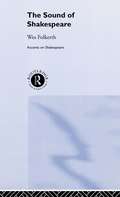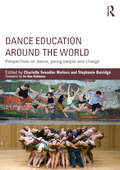- Table View
- List View
After Effects and Cinema 4D Lite: 3D Motion Graphics and Visual Effects Using CINEWARE
by Chris JacksonOne of the most exciting new features in After Effects is the integration of Cinema 4D using the CINEWARE plug-in and a free version of Cinema 4D Lite. Both provide a wide assortment of new 3D tools and options that are difficult or nearly impossible to achieve in After Effects alone. This book clearly demonstrates how the new 3D workflow bridges the two applications together to raise the design bar for motion graphics and broadcast design. Hands-on exercises teach you essential production skills including: Modeling in CINEMA 4D Lite Importing 3D models in After Effects Tracking 3D motion in After Effects Compositing with CINEWARE Using MoGraph features in CINEMA 4D Rendering and optimization techniques Additional online materials include project files and videos showcasing the techniques covered in the book. To access these materials, please see the 'eResources' tab.
Comedy for Animators
by Jonathan LyonsWhile comedy writers are responsible for creating clever scripts, comedic animators have a much more complicated problem to solve: What makes a physical character funny? Comedy for Animators breaks down the answer by exploring the techniques of those who have used their bodies to make others laugh. Drawing from traditions such as commedia dell'arte, pantomime, Vaudeville, the circus, and silent and modern film, animators will learn not only to create funny characters, but also how to execute gags, create a comic climate, and use environment as a character. Whether you're creating a comic villain or a bumbling sidekick, this is the one and only guide you need to get your audience laughing! Explanation of comedic archetypes and devices will both inspire and inform your creative choices Exploration of various modes of storytelling allows you to give the right context for your story and characters Tips for creating worlds, scenarios, and casts for your characters to flourish in Companion website includes example videos and further resources to expand your skillset--check it out at www.comedyforanimators.com! Jonathan Lyons delivers simple, fun, illustrated lessons that teach readers to apply the principles of history's greatest physical comedians to their animated characters. This isn't stand-up comedy--it's the falling down and jumping around sort!
Studio Television Production and Directing: Concepts, Equipment, and Procedures
by Andrew UtterbackMaster the fundamentals of studio production procedure and become an effective leader on set. Gain fluency in essential studio terms and technology and acquire the skills you need to make it in the industry. Elegant, accessible, and to the point, the second edition of Andrew H. Utterback’s Studio Television Production and Directing is your back-to-the-basics guide to studio-based lighting, set design, camera operations, floor direction, technical direction, audio capture, graphics, prompting, and assistant directing. Whether you are an established studio professional or a student looking to enter the field, this book provides you with the technical expertise you need to successfully coordinate live or taped studio television in the digital age. This new edition has been updated to include: A UK/Euro focused appendix, enhancing the book’s accessibility to students and professionals of television production around the world An advanced discussion of the job of the Director and the Command Cue Language Fresh discussion of tapeless protocols in the control room, Media Object Server newsroom control software (iNews), editing systems, switcher embedded image store, and DPM (DVE) Brand new sections on UHDTV (4K), set design, lighting design, microphones, multiviewers, media asset management, clip-servers, and the use of 2D and 3D animation Expanded coverage of clip types used in ENG and video journalism (VO, VO/SOT, and PKG) An all new companion website (www.focalpress.com/cw/utterback) with pre-recorded lectures by the author, sample video clips, an expanded full color image archive, vocabulary flashcards, and more Note: the companion website is still under development, but in the meantime the author's filmed lectures are all freely available on Youtube: https://www.youtube.com/channel/UCRp_aSpO0y8cDqLjFGZ2s9A
Understanding the Business of Entertainment: The Legal and Business Essentials All Filmmakers Should Know
by Gregory BernsteinUnderstanding the Business of Entertainment: The Legal and Business Essentials All Filmmakers Should Know is an indispensable guide to the business aspects of the entertainment industry, providing the legal expertise you need to break in and to succeed.? Written in a clear and engaging tone, this book covers the essential topics in a thorough but reader-friendly manner and includes plenty of real-world examples that bring business and legal concepts to life. Whether you want to direct, produce, write, edit, photograph or act in movies, this book covers how to find work in your chosen field and examines the key provisions in employment agreements for creative personnel.? If you want to make films independently, you’ll find advice on where to look for financing, what kinds of deals might be made in the course of production, and important information on insurance, releases, and licenses.? ? Other topics covered include: Hollywood’s growth and the current conglomerates that own most of the media How specific entertainment companies operate, including facts about particular studios and employee tasks. How studios develop projects, manage production, seek out independent films, and engage in marketing and distribution The kinds of revenues studios earn and how they account for these revenues How television networks and new media-delivery companies like Netflix operate and where the digital revolution might take those who will one day work in the film and TV business As an award- winning screenwriter and entertainment attorney, Gregory Bernstein give us an inside look at the business of entertainment. He proves that knowing what is behind filmmaking is just as important as the film itself.
The Routledge Encyclopedia of Films
by John White Sarah Barrow Sabine HaenniThe Routledge Encyclopedia of Films comprises 200 essays by leading film scholars analysing the most important, influential, innovative and interesting films of all time. Arranged alphabetically, each entry explores why each film is significant for those who study film and explores the social, historical and political contexts in which the film was produced. Ranging from Hollywood classics to international bestsellers to lesser-known representations of national cinema, this collection is deliberately broad in scope crossing decades, boundaries and genres. The encyclopedia thus provides an introduction to the historical range and scope of cinema produced throughout the world.
Spanish-Language Television in the United States: Fifty Years of Development (Routledge Research in Cultural and Media Studies)
by Kenton T. WilkinsonSince its introduction in the early 1960s, Spanish-language television in the United States has grown in step with the Hispanic population. Industry and demographic projections forecast rising influence through the 21st century. This book traces U.S. Spanish-language television’s development from the 1960s to 2013, illustrating how business, regulation, politics, demographics and technological change have interwoven during a half century of remarkable change for electronic media. Spanish-language media play key social, political and economic roles in U.S. society, connecting many Hispanics to their cultures of origin, each other, and broader U.S. society. Yet despite the population’s increasing impact on U.S. culture, in elections and through an estimated $1.3 trillion in spending power in 2014, this is the first comprehensive academic source dedicated to the medium and its history. The book combines information drawn from the business press and trade journals with industry reports and academic research to provide a balanced perspective on the origins, maturation and accelerated growth of a significant ethnic-oriented medium.
The Filmmaker’s Guide to Digital Imaging: for Cinematographers, Digital Imaging Technicians, and Camera Assistants
by Blain BrownIt's a whole new world for cinematographers, camera assistants, and postproduction artists. New equipment, new methods, and new technologies have to be learned and mastered. New roles such as that of the DIT (Digital Imaging Technician), Digital Loader, and Data Manager are integral to today's motion picture production process. Take your mastery of these new tools, techniques, and roles to the next level with this cutting-edge roadmap from esteemed author and filmmaker Blain Brown. The Filmmaker's Guide to Digital Imaging covers both the theory and the practice, featuring full-color, in-depth coverage of essential terminology, technology, and industry-standard best-practices. Brown covers new industry-wide production standards such as ASC-CDL and the ACES workflow. Interviews with professional cinematographers and DITs working on Hollywood productions equip you with knowledge that is essential if you want to work in today's motion picture industry, whether as a cinematographer, DIT, Digital Loader, Data Manager, camera assistant, editor, or VFX artist. Topics include: Digital sensors and cameras The structure of digital images Waveform monitors, vectorscopes, and test charts Using linear, gamma, and log encoded video files Exposure techniques for HD and UltraHD Understanding digital color Codecs and file formats The DIT cart Downloading, ingesting, and managing video files Workflow from camera to DIT cart to post Using metadata and timecode The companion website (www.focalpress.com/cw/brown) features additional material, including demonstrations and interviews with experienced DITs and cinematographers.
Book of Sides: Original, One-Page Scenes for Actors and Directors
by Dave KostLooking for fresh, original scenes for your fast-paced acting or directing class? Tired of the same old material everyone recognizes? Want the flexibility to play any character in any scene? Book of Sides: Original, Short Scenes for Actors and Directors offers scenes that are considerably shorter than those in similar books but still feature the structure of typical scenes with arcs, clear playable objectives, and stakes for both actors. Here you will find scenes that are: One-page in length and specially designed for new, high-intensity exercises that help students develop quickly Printed in an easily readable, film-script format that provides plenty of room for annotations Completely original, allowing you to produce and distribute reinterpretations without worrying about copyright restrictions Universally castable, with roles that can be assigned to actors regardless of gender, appearance, skill level, or race Simple and conducive to performing in the classroom without props, costumes, or sets Perfect for audition workshops and crowded directing or acting classes where everyone wants an opportunity to perform Written in accessible, contemporary language that keeps student actors engaged Don’t miss out! In Book of Sides, Dave Kost brings two decades of teaching experience to the table to deliver the ideal set of scenes for busy classroom settings, auditions, and general training.
Cinema 4D Apprentice: Real-World Skills for the Aspiring Motion Graphics Artist (Apprentice Series)
by Kent McQuilkinNew to CINEMA 4D and looking for an accessible way to get up to speed quickly? Do you already know the basics of the software but need to know the new features or take your skills and understanding a little deeper? If so, look no further than CINEMA 4D Apprentice, your one-stop shop for learning this powerful application. With guidance that takes you beyond just the button-pushing, author Kent McQuilkin guides you through 10 core lessons, starting with the basics before moving onto more complex techniques and concepts and then tying it all together with a final project. CINEMA 4D Apprentice walks you through the software with a project-based approach, allowing you to put lessons learned into immediate practice. Best practices and workflows for motion graphics artists that can be applied to any software application are included. A companion website (www.focalpress.com/cw/mcquilkin) features project files and videos of the techniques in action. Topics covered include: creating basic scenes, modeling, texture mapping mograph in-depth integration with After Effects via CINEWARE lighting, animation, rendering and more motion tracking with the new tools included in R16
Film Genre for the Screenwriter
by Jule SelboFilm Genre for the Screenwriter is a practical study of how classic film genre components can be used in the construction of a screenplay. Based on Jule Selbo’s popular course, this accessible guide includes an examination of the historical origins of specific film genres, how and why these genres are received and appreciated by film-going audiences, and how the student and professional screenwriter alike can use the knowledge of film genre components in the ideation and execution of a screenplay. Explaining the defining elements, characteristics and tropes of genres from romantic comedy to slasher horror, and using examples from classic films like Casablanca alongside recent blockbuster franchises like Harry Potter, Selbo offers a compelling and readable analysis of film genre in its written form. The book also offers case studies, talking points and exercises to make its content approachable and applicable to readers and writers across the creative field.
The Routledge Companion to Theatre and Performance (Routledge Companions)
by Paul Allain Jen HarvieWhat is theatre? What is performance? What connects them and how are they different? What events, people, practices and ideas have shaped theatre and performance in the twentieth and twenty-first century? The Routledge Companion to Theatre and Performance offers some answers to these big questions. It provides an analytical, informative and engaging introduction to important people, companies, events, concepts and practices that have defined the complementary fields of theatre and performance studies. This fully updated second edition contains three easy to use alphabetized sections including over 120 revised entries on topics and people ranging from performance artist Ron Athey, to directors Vsevold Meyerhold and Robert Wilson, megamusicals , postdramatic theatre and documentation. Each entry includes crucial historical and contextual information, extensive cross-referencing, detailed analysis and an annotated bibliography. The Routledge Companion to Theatre and Performance is a perfect reference guide for the keen student.
What's the Story: Essays about art, theater and storytelling
by Anne BogartAnne Bogart is an award-winning theatre maker, and a best-selling writer of books about theatre, art, and cultural politics. In this her latest collection of essays she explores the story-telling impulse, and asks how she, as a ‘product of postmodernism’, can reconnect to the primal act of making meaning and telling stories. She also asks how theatre practitioners can think of themselves not as stagers of plays but ‘orchestrators of social interactions’ and participants in an on-going dialogue about the future. We dream. And then occasionally we attempt to share our dreams with others. In recounting our dreams we try to construct a narrative... We also make stories out of our daytime existence. The human brain is a narrative creating machine that takes whatever happens and imposes chronology, meaning, cause and effect... We choose. We can choose to relate to our circumstances with bitterness or with openness. The stories that we tell determine nothing less than personal destiny. (From the introduction) This compelling new book is characteristically made up of chapters with one-word titles: Spaciousness, Narrative, Heat, Limits, Error, Politics, Arrest, Empathy, Opposition, Collaboration and Sustenance. In addition to dipping into neuroscience, performance theory and sociology, Bogart also recounts vivid stories from her own life. But as neuroscience indicates, the event of remembering what happened is in fact the creation of something new.
Writing for the Green Light: How to Make Your Script the One Hollywood Notices
by Scott KirkpatrickTailor your screenplay to sell. Find out what Hollywood script readers, producers, and studio executives want in a screenplay (and why) from someone who’s been there. Discover what it takes to begin a lasting career as a screenwriter. Peppered with interviews from established professionals, Writing for the Green Light: How to Make Your Script the One Hollywood Notices gives you a sharp competitive edge by showcasing dozens of everyday events that go on at the studios but are rarely if ever discussed in most screenwriting books. With his behind-the-scenes perspective, Scott Kirkpatrick shows you why the system works the way it does and how you can use its unwritten rules to your advantage. He answers such questions as: Who actually reads your script? How do you pique the interest of studios and decision makers? What do agents, producers, and production companies need in a script? How much is a script worth? What are the best genres for new writers and why? What are real steps you can take to ‘break in’ to television writing? How do you best present or pitch a project without looking desparate? How do you negotiate a contract without an agent? How do you exude confidence and seal your first deal? These and other insights are sure to give you and your screenplay a leg-up for success in this competitive landscape!
African American Viewers and the Black Situation Comedy: Situating Racial Humor (Studies in African American History and Culture)
by Robin R. Means ColemanProviding new insight into key debates over race and representation in the media, this ethnographic study explores the ways in which African Americans have been depicted in Black situation comedies-from 1950's Beulah to contemporary series like Martin and Living Single.
An Encyclopedic Dictionary of Women in Early American Films: 1895-1930
by Denise LoweExamine women&’s contributions to film-in front of the camera and behind it! An Encyclopedic Dictionary of Women in Early American Films: 1895-1930 is an A-to-Z reference guide (illustrated with over 150 hard-to-find photographs!) that dispels the myth that men dominated the film industry during its formative years. Denise Lowe, author of Women and American Television: An Encyclopedia, presents a rich collection that profiles many of the women who were crucial to the development of cinema as an industry-and as an art form. Whether working behind the scenes as producers or publicists, behind the cameras as writers, directors, or editors, or in front of the lens as flappers, vamps, or serial queens, hundreds of women made profound and lasting contributions to the evolution of the motion picture production. An Encyclopedic Dictionary of Women in Early American Films: 1895-1930 gives you immediate access to the histories of many of the women who pioneered the early days of cinema-on screen and off. The book chronicles the well-known figures of the era, such as Alice Guy, Mary Pickford, and Francis Marion but gives equal billing to those who worked in anonymity as the industry moved from the silent era into the age of sound. Their individual stories of professional success and failure, artistic struggle and strife, and personal triumph and tragedy fill in the plot points missing from the complete saga of Hollywood&’s beginnings. Pioneers of the motion picture business found in An Encyclopedic Dictionary of Women in Early American Films include: Dorothy Arnzer, the first woman to join the Directors Guild of America and the only female director to make a successful transition from silent films to sound Jane Murfin, playwright and screenwriter who became supervisor of motion pictures at RKO Studios Gene Gauntier, the actress and scenarist whose adaptation of Ben Hur for the Kalem Film Company led to a landmark copyright infringement case Theda Bara, whose on-screen popularity virtually built Fox Studios before typecasting and overexposure destroyed her career Madame Sul-Te-Wan, née Nellie Conley, the first African-American actor or actress to sign a film contract and be a featured performer Dorothy Davenport, who parlayed the publicity surrounding her actor-husband&’s drug-related death into a career as a producer of social reform melodramas Lois Weber, a street-corner evangelist who became one of the best-known and highest-paid directors in Hollywood Lina Basquette, the "Screen Tragedy Girl" who married and divorced studio mogul Sam Warner, led The Hollywood Aristocrats Orchestra, claimed to have been a spy for the American Office of Strategic Services during World War II, and became a renowned dog expert in her later years and many more! An Encyclopedic Dictionary of Women in Early American Films: 1895-1930 also includes comprehensive appendices of the WAMPAS Baby Stars, the silent stars remembered in the Graumann Chinese Theater Forecourt of the Stars and those immortalized on the Hollywood Walk of Stars. The book is invaluable as a resource for researchers, librarians, academics working in film, popular culture, and women&’s history, and to anyone interested either professionally or casually in the early days of Hollywood and the motion picture industry.
Auditions: The Complete Guide
by Richard EvansAuditions are an integral part of every performer's life. From getting into drama school through to a successful career in an overcrowded industry, Auditions: The Complete Guide offers crucial advice, resources and tried and tested techniques to maximise success before, during and after each audition. Written by an established casting director and former actor, with over 35 years of experience on a wide range of productions, this book offers a wealth of personal and professional insights, covering: • drama and theatre schools • showcases • amateur and professional auditions • contemporary, classical, physical and musical theatre • television and commercial castings, movie screen tests and self taping • voice-overs and radio drama • networking • recalls and workshops • handling job offers, and rejection From training to triumph, nerves to networking and camera to casting couch, Auditions: The Complete Guide is an entertaining, accessible and indispensable read for every performer. Richard Evans CDG has cast a wide variety of productions in all media since 1989 and, prior to this, worked as an actor for 10 years. He has devised and presented audition and career development workshops at many top drama and theatre schools worldwide, and at the Actors Centre, London and has written Auditions: A Practical Guide (Routledge, 2009) and 'A Casting Director’s Perspective' for The Actors’ Yearbook, 2005. He is a member of The Casting Directors’ Guild of Great Britain and Ireland. www.auditionsthecompleteguide.com
The Visual Story: Creating the Visual Structure of Film, TV, and Digital Media
by Bruce BlockThis updated edition of a best-selling classic shows you how to structure your visuals as carefully as a writer structures a story or composers structure their music. The Visual Story teaches you how to design and control the structure of your production using the basic visual components of space, line, shape, tone, color, movement, and rhythm. You can use these components to effectively convey moods and emotions, create a visual style, and utilize the important relationship between the visual and the story structures. Using over 700 color illustrations, author Bruce Block explains how understanding the connection between story and visual structures will guide you in the selection of camera angles, lenses, actor staging, composition, set design and locations, lighting, storyboard planning, camera coverage, and editing. The Visual Story is an ideal blend of theory and practice. The concepts and examples in this new edition will benefit students learning cinematic production, as well as professional writers, directors, cinematographers, art directors, animators, game designers, and anyone working in visual media who wants a better understanding of visual structure.
Horror Film and Affect: Towards a Corporeal Model of Viewership (Routledge Advances in Film Studies)
by Xavier Aldana ReyesThis book brings together various theoretical approaches to Horror that have received consistent academic attention since the 1990s – abjection, disgust, cognition, phenomenology, pain studies – to make a significant contribution to the study of fictional moving images of mutilation and the ways in which human bodies are affected by those on the screen on three levels: representationally, emotionally and somatically. Aldana Reyes reads Horror viewership as eminently carnal, and seeks to articulate the need for an alternative model that understands the experience of feeling under corporeal threat as the genre’s main descriptor. Using recent, post-millennial examples throughout, the book also offers case studies of key films such as Hostel, [REC], Martyrs or Ginger Snaps, and considers contemporary Horror strands such as found footage or 3D Horror.
The Technical Director's Toolkit: Process, Forms, and Philosophies for Successful Technical Direction (The Focal Press Toolkit Series)
by Zachary Stribling Richard GirtainIn the world of theatre, the technical director is responsible for overseeing the safe and efficient realization and implementation of scenery for the stage. The Technical Director’s Toolkit is the first book to address every nut and bolt of this multifaceted job, guiding you though the step-by-step processes of technical direction and the responsibilities of the TD in the mounting of a theatrical production. Leadership, management, relationship building, personal responsibility, and problem solving are addressed, showing you not only how to become a more efficient and effective TD, but also how to be a collaborative member of a production team that artists will seek to work with again and again. The book also addresses scene shop design, facility repair and maintenance, and finishes with a brief overview of other areas of technical theatre that help round out the far reaching skill set of a successful TD.
Modern Post: Workflows and Techniques for Digital Filmmakers
by Scott Arundale Tashi TrieuWith the shift from film to digital, today’s filmmakers are empowered by an arsenal of powerful, creative options with which to tell their story. Modern Post examines and demystifies these tools and workflows and demonstrates how these decisions can empower your storytelling. Using non-technical language, authors Scott Arundale and Tashi Trieu guide you through everything you should consider before you start shooting. They begin with a look to past methodologies starting with traditional film techniques and how they impact current trends. Next they offer a look at the latest generation of digital camera and capture systems. The authors move on to cover: * Preproduction- what camera is best for telling your story and why, budgeting for post* Production- on-set data management, dailies, green screen, digital cinematography* Postproduction- RAW vs. compressed footage, editing, visual effects, color correction, sound and deliverables including DCP creation The book features cutting-edge discussion about the role of the digital imaging technician (DIT), how you can best use the Cloud, motion graphics, sound design, and much more. Case studies show you these solutions being applied in real-world situations, and the companion website features videos of techniques discussed in the book, as well as timely updates about technological changes in the landscape. www.focalpress.com/cw/arundale
Chinese Television in the Twenty-First Century: Entertaining the Nation (Routledge Contemporary China Series)
by Ruoyun Bai Geng SongThe past two decades witnessed the rise of television entertainment in China. Although television networks are still state-owned and Party-controlled in China, the ideological landscape of television programs has become increasingly diverse and even paradoxical, simultaneously subservient and defiant, nationalistic and cosmopolitan, moralistic and fun-loving, extravagant and mundane. Studying Chinese television as a key node in the network of power relationships, therefore, provides us with a unique opportunity to understand the tension-fraught and , paradox-permeated conditions of Chinese post-socialism. This book argues for a serious engagement with television entertainment. rethinking, It addresses the following questions. How is entertainment television politically and culturally significant in the Chinese context? How have political, industrial, and technological changes in the 2000s affected the way Chinese television relates to the state and society? How can we think of media regulation and censorship without perpetuating the myth of a self-serving authoritarian regime vs. a subdued cultural workforce? What do popular televisual texts tell us about the unsettled and reconfigured relations between commercial television and the state? The book presents a number of studies of popular television programs that are sensitive to the changing production and regulatory contexts for Chinese television in the twenty-first century. As an interdisciplinary study of the television industry, this book covers a number of important issues in China today, such as censorship, nationalism, consumerism, social justice, and the central and local authorities. As such, it will appeal to a broad audience including students and scholars of Chinese culture and society, media studies, television studies, and cultural studies.
Queering Teen Culture: All-American Boys and Same-Sex Desire in Film and Television
by Jeffery P DennisWhy did Fonzie hang around with all those high school boys?Is the overwhelming boy-meets-girl content of popular teen movies, music, books, and TV just a cover for an undercurrent of same-sex desire? From the 1950s to the present, popular culture has involved teenage boys falling for, longing over, dreaming about, singing to, and fighting over, teenage girls. But Queering Teen Culture analyzes more than 200 movies and TV shows to uncover who Frankie Avalon&’s character was really in love with in those beach movies and why Leif Garrett became a teen idol in the 1970s. In Top 40 songs, teen magazines, movies, TV soap operas and sitcoms, teenagers are defined by their pubescent "discovery" of the opposite sex, universally and without exception. Queering Teen Culture looks beyond the litany to find out when adults became so insistent about teenage sexual desire-and why-and finds evidence of same-sex desire, romantic interactions, and identities that, according to the dominant ideology, do not and cannot exist. This provocative book examines the careers of male performers whose teenage roles made them famous (including Ricky Nelson, Pat Boone, Fabian, and James Darren) and discusses examples of lesbian desire (including I Love Lucy and Laverne and Shirley). Queering Teen Culture examines: Ozzie and Harriet, Father Knows Best, and Leave It to Beaver: Were Ricky, Bud, and Wally sufficiently straight? the juvenile delinquent films of the 1950s: Why weren&’t the rebel-without-a-cause "bad boys" interested in girls? horror, sci-fi, and zombies from outer space: "Body of a boy! Mind of a monster! Soul of an unearthly thing!" teen idols-pretty, androgynous, and feminine: No wonder they were rumored to be "funny" beach movies: She wants to plan their wedding but he wants to surf, sky-dive and go drag racing with the guys Biker-hippies boys of the late 1960s: "I know your scene-don&’t think I don&’t!" the 1950s nostalgia of the 1970s: Why does Fonzie spend all his time with high school boys? teen gore: What makes the psycho-killer angry? and much more, including Gidget, the Brat Pack, buddy dramas, nerds and "operators," Saved by the Bell, The Real World, and the incredible shrinking teenager Queering Teen Culture is an essential read for academics working in cultural and gay studies, and for anyone else with an interest in popular culture.
Food in Film: A Culinary Performance of Communication (Studies in American Popular History and Culture)
by Jane FerryFirst published in 2003. Routledge is an imprint of Taylor & Francis, an informa company.
The Sound of Shakespeare (Accents on Shakespeare)
by Wes FolkerthThe 'Sound of Shakespeare' reveals the surprising extent to which Shakespeare's art is informed by the various attitudes, beliefs, practices and discourses that pertained to sound and hearing in his culture. In this engaging study, Wes Folkerth develops listening as a critical practice, attending to the ways in which Shakespeare's plays express their author's awareness of early modern associations between sound and particular forms of ethical and aesthetic experience. Through readings of the acoustic representation of deep subjectivity in Richard III, of the 'public ear' in Antony and Cleopatra, the receptive ear in Coriolanus, the grotesque ear in A Midsummer Night's Dream, the 'greedy ear' in Othello, and the 'willing ear' in Measure for Measure, Folkerth demonstrates that by listening to Shakespeare himself listening, we derive a fuller understanding of why his works continue to resonate so strongly with is today.
Dance Education around the World: Perspectives on dance, young people and change
by Charlotte Svendler Nielsen Stephanie BurridgeDance has the power to change the lives of young people. It is a force in shaping identity, affirming culture and exploring heritage in an increasingly borderless world. Creative and empowering pedagogies are driving curriculum development worldwide where the movement of peoples and cultures generates new challenges and possibilities for dance education in multiple contexts. In Dance Education around the World: Perspectives on Dance, Young People and Change, writers across the globe come together to reflect, comment on and share their expertise and experiences. The settings are drawn from a spectrum of countries with contributions from Europe, the Americas, the Middle East, Asia, the Pacific and Africa giving insights and fresh perspectives into contrasting ideas, philosophies and approaches to dance education from Egypt to Ghana, Brazil to Finland, Jamaica to the Netherlands, the UK, USA, Australia, New Zealand and more. This volume offers chapters and narratives on: Curriculum developments worldwide Empowering communities through dance Embodiment and creativity in dance teaching Exploring and assessing learning in dance as artistic practice Imagined futures for dance education Reflection, evaluation, analysis and documentation are key to the evolving ecology of dance education and research involving individuals, communities and nations. Dance Education around the World: Perspectives on Dance, Young People and Change provides a great resource for dance educators, practitioners and researchers, and pushes for the furtherance of dance education around the world. Charlotte Svendler Nielsen is Assistant professor and head of educational studies at the Department of Nutrition, Exercise and Sports, research group Body, Learning and Identity, University of Copenhagen, Denmark. Stephanie Burridge lectures at Lasalle College of the Arts and Singapore Management University, and is the series editor for Routledge Celebrating Dance in Asia and the Pacific.
